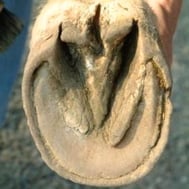Consistency is key with hoof hydration
 The hooves lie at the base of a horse’s entire body, which means hoof health affects the overall well-being of a horse. When it comes to keeping hooves healthy, hoof hydration, and transitioning between wet and dry ground surfaces, is one of the biggest problems.
The hooves lie at the base of a horse’s entire body, which means hoof health affects the overall well-being of a horse. When it comes to keeping hooves healthy, hoof hydration, and transitioning between wet and dry ground surfaces, is one of the biggest problems.
Since climate varies across regions, from subtropical East Texas to the deserts of Nevada, the “normal” amount of moisture content in horse hooves differs depending on where they live. The best thing horse owners and farriers can do for their horse’s hooves is hydrate the hooves consistently. To maintain hoof wall integrity, horse owners should prepare for changes in weather, identify fluctuations in hooves’ moisture content and initiate extra support when needed.
Overhydration Versus Dehydration
The hoof itself is like a sponge. When it gets wet, the hoof increases in size and becomes vulnerable and soft. Since the foot is more fragile in this state, over-hydration can cause the hoof to flare, break or crack. Farriers will be able to see this issue visibly and should take steps toward treatment right away in order to avoid sole thinning.
On the other hand, a dry hoof is smaller, hard and rigid. The hoof is as tough as the ground it walks on, and there are no visible signs of dehydration. However, when farriers go to trim the hoof, the trimming doesn’t quite cut like a normally-hydrated foot. Hydrated hooves are easier to trim just as a wet sponge is easier to manipulate than a dry sponge.
Wet or Dry, Pick One
Regardless of what level of moisture a horse’s feet are used to, aim to maintain that level and avoid large deviation. This is especially critical for the horses that live in conditions that adjust daily. For example, if a horse stays in a dry stall overnight, then ventures out to wet, dewy grass in the morning and goes back and forth multiple times a day, the constant switching can eventually lead to a loss of integrity of the exterior hoof wall, and then to thin soles. Thin soles can cause a horse discomfort, and if left untreated, they can deteriorate the horse’s feet over time. After days and weeks of dramatic changes in a hoof’s moisture content, the hoof loses its structure and breaks down.
How to Keep Hydration Stable
Maintaining consistent hoof hydration starts with understanding the environment the horse lives in. If a horse encounters different ground surfaces throughout the day, applying a barrier, like a hoof sealant or water repellent, can help the hoof simultaneously repel outside moisture and retain the wetness it already has. Farriers can use a hoof sealant before sending their horses out to the grass in the mornings and then apply it again before bathing. This technique is short-lived but temporarily blocks water from getting to the foot.
As for extended weather changes, a more permanent solution will help with hydration. Pour-in pad materials bond to a horse’s sole to form a platform between the bare hoof and the ground. Since most moisture is lost and gained through the sole, this platform helps maintain hydration levels by blocking water from passing in and out, which limits moisture fluctuation.
For a comfortable material that absorbs concussion and shock, farriers can apply Equi-Pak to their horses’ hooves. The pour-in material dries about a minute after application and lasts for an entire shoeing cycle.
As fall fades into winter, horse owners can expect to see changes in their animals’ environment. With proper hoof care and an attentive eye on moisture content, horses will thrive no matter what mother nature brings.